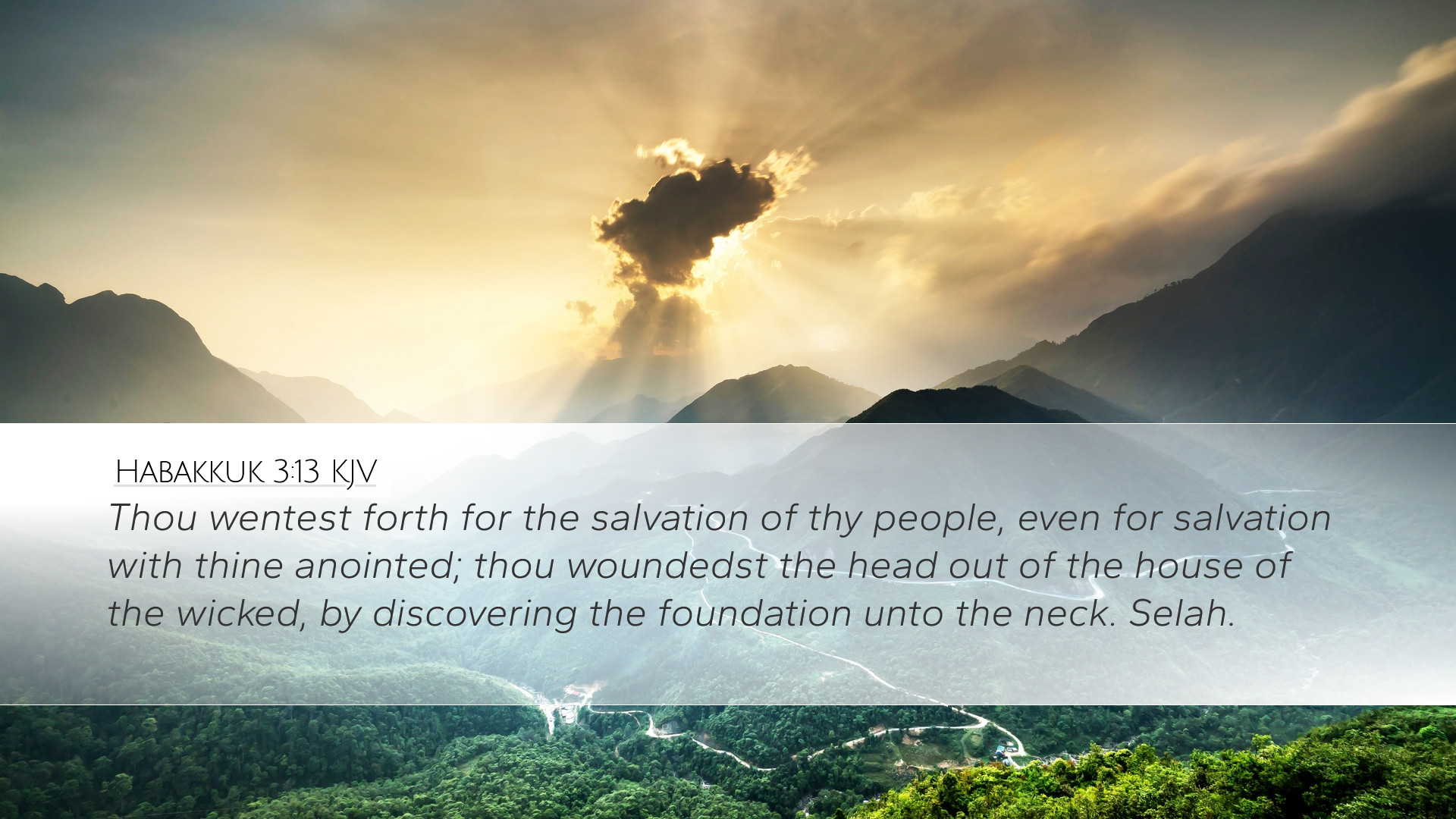Old Testament
Genesis Exodus Leviticus Numbers Deuteronomy Joshua Judges Ruth 1 Samuel 2 Samuel 1 Kings 2 Kings 1 Chronicles 2 Chronicles Ezra Nehemiah Esther Job Psalms Proverbs Ecclesiastes Song of Solomon Isaiah Jeremiah Lamentations Ezekiel Daniel Hosea Joel Amos Obadiah Jonah Micah Nahum Habakkuk Zephaniah Haggai Zechariah MalachiHabakkuk 3:13
Habakkuk 3:13 KJV
Thou wentest forth for the salvation of thy people, even for salvation with thine anointed; thou woundedst the head out of the house of the wicked, by discovering the foundation unto the neck. Selah.
Habakkuk 3:13 Bible Commentary
Commentary on Habakkuk 3:13
Habakkuk 3:13 states:
"Thou wentest forth for the salvation of thy people, even for salvation with thine anointed; thou woundedst the head out of the house of the wicked, by discovering the foundation unto the neck."
Overview
This verse encapsulates a profound theological concept regarding God’s intervention for His people and the eventual triumph over evil. It portrays God as a warrior working to deliver His people and defeat their enemies. This commentary will explore elements from notable public domain commentaries, providing deep insights for pastors, students, theologians, and Bible scholars.
God’s Initiative in Salvation
Matthew Henry emphasizes that the phrase "Thou wentest forth for the salvation of thy people" signifies God's active role in salvation. It is not merely the people's effort or worthiness that leads to deliverance, but divine initiative. This aspect highlights God's covenant faithfulness toward Israel and illustrates a theme prevalent throughout Scripture—that God hears the cries of His people and is moved to act.
He further suggests that salvation in Habakkuk’s context pertains both to physical deliverance from oppression and spiritual restoration. God’s going forth against oppressors demonstrates His commitment not only to the temporal welfare of His people but their eternal salvation.
The Anointed One
Albert Barnes notes the significance of the term "thine anointed." This reference points to the Messiah, the chosen one through whom God's salvation plan unfolds. In this light, Barnes perceives a prophetic foreshadowing of Christ, as the ultimate deliverer who confronts evil and unravels the wicked's foundations. This interpretation links the prophetic literature of the Old Testament with the revelation in the New Testament, offering rich layers of meaning regarding Christ’s salvific work.
The Defeat of the Wicked
The phrase "thou woundedst the head out of the house of the wicked" carries dramatic imagery. Adam Clarke elaborates on this pictorial language by affirming that it symbolizes a decisive blow against the wicked, akin to a warrior delivering a fatal strike to an enemy leader. This imagery of wounding the head alludes to the defeat of the powers of evil, echoing Genesis 3:15, where God promises enmity between the woman’s seed and the serpent.
Theological Applications
The actions of God as described in this verse derive significant theological implications. Firstly, we recognize God as a sovereign being who actively engages in human history for the sake of His people. Secondly, it acknowledges the reality of evil and God's overarching plan to bring justice, showcasing His power to redeem and restore. Here, scholars can also draw parallels to Christ’s victory over sin and death, providing a lens through which to view God’s redemptive history.
Practical Reflections for Believers
Pastors and theologians can distill several practical reflections from this commentary:
- Trust in God’s Deliverance: Habakkuk's declaration serves as a reminder to trust in God's provision even amid suffering. Believers can draw strength from the understanding that God is actively working for their salvation.
- The Role of Christ: The acknowledgment of the "anointed one" highlights the necessity of Christ in the believers’ salvific journey. Recognizing Christ’s role can deepen worship and gratitude among congregants.
- Active Participation: Just as God participated in the struggle against evil, Christians are called to act in ways that align with God's justice and righteousness, contributing to the Kingdom work on earth.
Conclusion
In closing, Habakkuk 3:13 encapsulates the profound truth of God's intervention in salvation history, the promise of the Messiah, and the defeat of evil. Scholars and students engaged in this text can appreciate its complexity and the numerous ways it interweaves with broader biblical themes. By engaging with the insights from public domain commentaries, we discern a roadmap for understanding God’s character and His purposes in our lives today.


